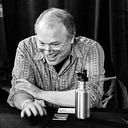This is wonderful work from every dimension — the physical, the art historical, and others. Thank you for sharing it with me.
In a bit of coincidence, I was at the Letterform Archive in San Francisco earlier in June, and had brought my 1904 book with me to show them; the director pulled out that 1935 copy of PM you cite, which I hadn’t seen before! The Sandberg one I was unaware of; I see ABEBooks has a copy for $2,000!
One note about flong in your paper, though. Flong went through several stages. It started with plaster and clay and other attempts through the early 19th century. Then it shifted into the much easier blotting/tissue paper combination known as wet flong. It still required a lot of hand work, but it was consistent and easy to work with relative to plaster. It could also be dried quickly.
However, by the era of the 1904 book I found—and starting several years earlier based on the accounts I’ve read—the wood-pulp-based dry flong became the primary tool for making paper matrices, especially in newspapers. These came in dry sheets and weren’t made as papier-mache, but rather just had to be conditioned in a humidor to make them pliable, then applied under pressure.
So the Debords books would have relied on dry flong. The older wet flong would likely have shattered or fallen apart by now, as it was so fragile. Even if any were kept (and I’ve seen perhaps none from that period in the 19th century), it would likely not remain in a condition that could be handled today.
